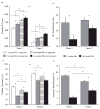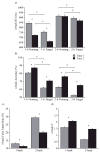Tracking the relationship between children's aerobic fitness and cognitive control
- PMID: 27089460
- PMCID: PMC4993702
- DOI: 10.1037/hea0000343
Tracking the relationship between children's aerobic fitness and cognitive control
Abstract
Objective: To investigate if changes in aerobic fitness over a 3-year period are associated with modulations in children's cognitive control.
Method: A sample of 2nd/3rd-grade children (N = 290) completed baseline measures in Fall of 2011, and again in Spring of 2014 at the end of 4th/5th grade. Children completed the Progressive Aerobic Cardiovascular Endurance Run (PACER) test to measure aerobic capacity, a flanker task to evaluate inhibitory control, and an n-back task to assess working memory. Aerobic fitness was included as an independent variable in hierarchical regression analyses conducted at both time points, in addition to analyses examining changes in cognition over time.
Results: At baseline, higher fit children exhibited shorter overall flanker reaction time (RT), as well as superior accuracy and d' scores (i.e., target discrimination) for both 1- and 2-back conditions. Approximately 3 years later, higher levels of fitness were associated with better performance for only the most difficult conditions of each task, including greater incongruent flanker accuracy and less interference during the compatible condition, as well as better accuracy and target discrimination for the 2-back condition of the n-back task. Importantly, increases in fitness were independently related to improvements in incongruent flanker accuracy and 2-back d' scores.
Conclusions: The current findings indicate that both higher aerobic fitness levels as well as increases in children's fitness are associated with better performance for task conditions eliciting greater cognitive demand. Such evidence is vital for implementing future health recommendations intended to foster improved cognitive performance in children. (PsycINFO Database Record
(c) 2016 APA, all rights reserved).
Figures


References
-
- Carrel AL, Clark RR, Peterson SE, Nemeth BA, Sullivan J, Allen DB. Improvement of fitness, body composition, and insulin sensitivity in overweight children in a school-based exercise program: A randomized, controlled study. Archives of Pediatrics & Adolescent Medicine. 2005;159(10):963–968. doi: 10.1001/archpedi.159.10.963. - DOI - PubMed
Publication types
MeSH terms
Grants and funding
LinkOut - more resources
Full Text Sources
Other Literature Sources
Medical

